LAW205 Essay: Circumstances for Lifting the Corporate Veil
VerifiedAdded on 2023/01/17
|7
|1918
|31
Essay
AI Summary
This essay examines the concept of lifting the corporate veil in Australian commercial and corporate law. It begins by establishing the principle of separate legal entity and limited liability, as established in Salomon v Salomon & Co Ltd, and how the corporate veil protects directors and shareholders from personal liability. However, it explores the circumstances under which the courts can lift the corporate veil, such as fraud, sham or façade, agency, unfairness/justice, and group enterprises. The essay analyzes relevant case laws, including Gilford Motor Co Ltd v Horne, Barrow v CSR Ltd, and ASIC v Adler, to illustrate how courts determine when to hold directors or members personally liable for their actions. It also discusses the duties of directors under the Corporations Act 2001 (Cth) and how the violation of these duties can lead to the lifting of the corporate veil. In conclusion, the essay highlights the importance of the corporate veil while also emphasizing that courts will lift it when necessary to prevent misuse of the corporate structure for illegal or immoral practices.
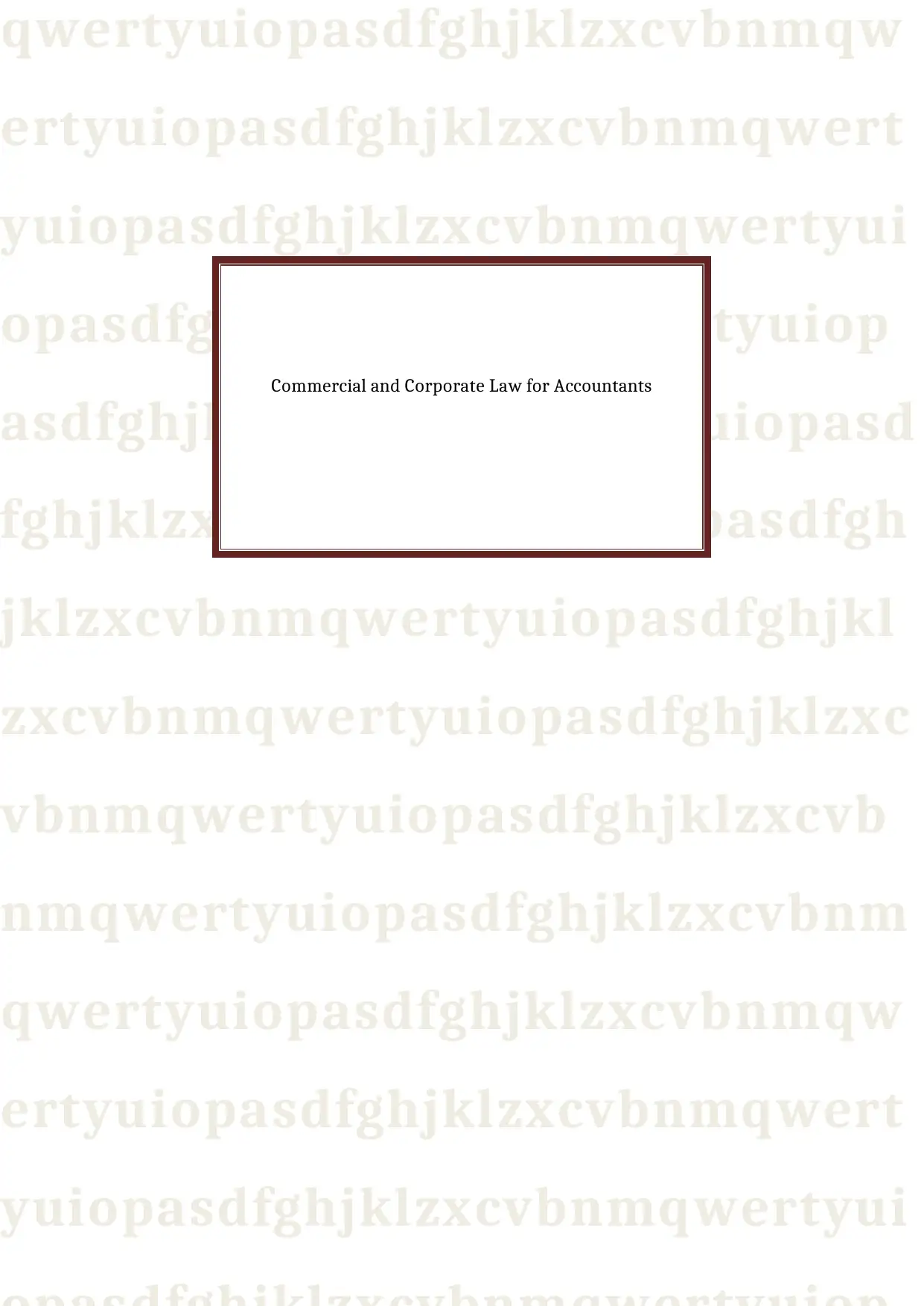
qwertyuiopasdfghjklzxcvbnmqw
ertyuiopasdfghjklzxcvbnmqwert
yuiopasdfghjklzxcvbnmqwertyui
opasdfghjklzxcvbnmqwertyuiop
asdfghjklzxcvbnmqwertyuiopasd
fghjklzxcvbnmqwertyuiopasdfgh
jklzxcvbnmqwertyuiopasdfghjkl
zxcvbnmqwertyuiopasdfghjklzxc
vbnmqwertyuiopasdfghjklzxcvb
nmqwertyuiopasdfghjklzxcvbnm
qwertyuiopasdfghjklzxcvbnmqw
ertyuiopasdfghjklzxcvbnmqwert
yuiopasdfghjklzxcvbnmqwertyui
Commercial and Corporate Law for Accountants
ertyuiopasdfghjklzxcvbnmqwert
yuiopasdfghjklzxcvbnmqwertyui
opasdfghjklzxcvbnmqwertyuiop
asdfghjklzxcvbnmqwertyuiopasd
fghjklzxcvbnmqwertyuiopasdfgh
jklzxcvbnmqwertyuiopasdfghjkl
zxcvbnmqwertyuiopasdfghjklzxc
vbnmqwertyuiopasdfghjklzxcvb
nmqwertyuiopasdfghjklzxcvbnm
qwertyuiopasdfghjklzxcvbnmqw
ertyuiopasdfghjklzxcvbnmqwert
yuiopasdfghjklzxcvbnmqwertyui
Commercial and Corporate Law for Accountants
Paraphrase This Document
Need a fresh take? Get an instant paraphrase of this document with our AI Paraphraser
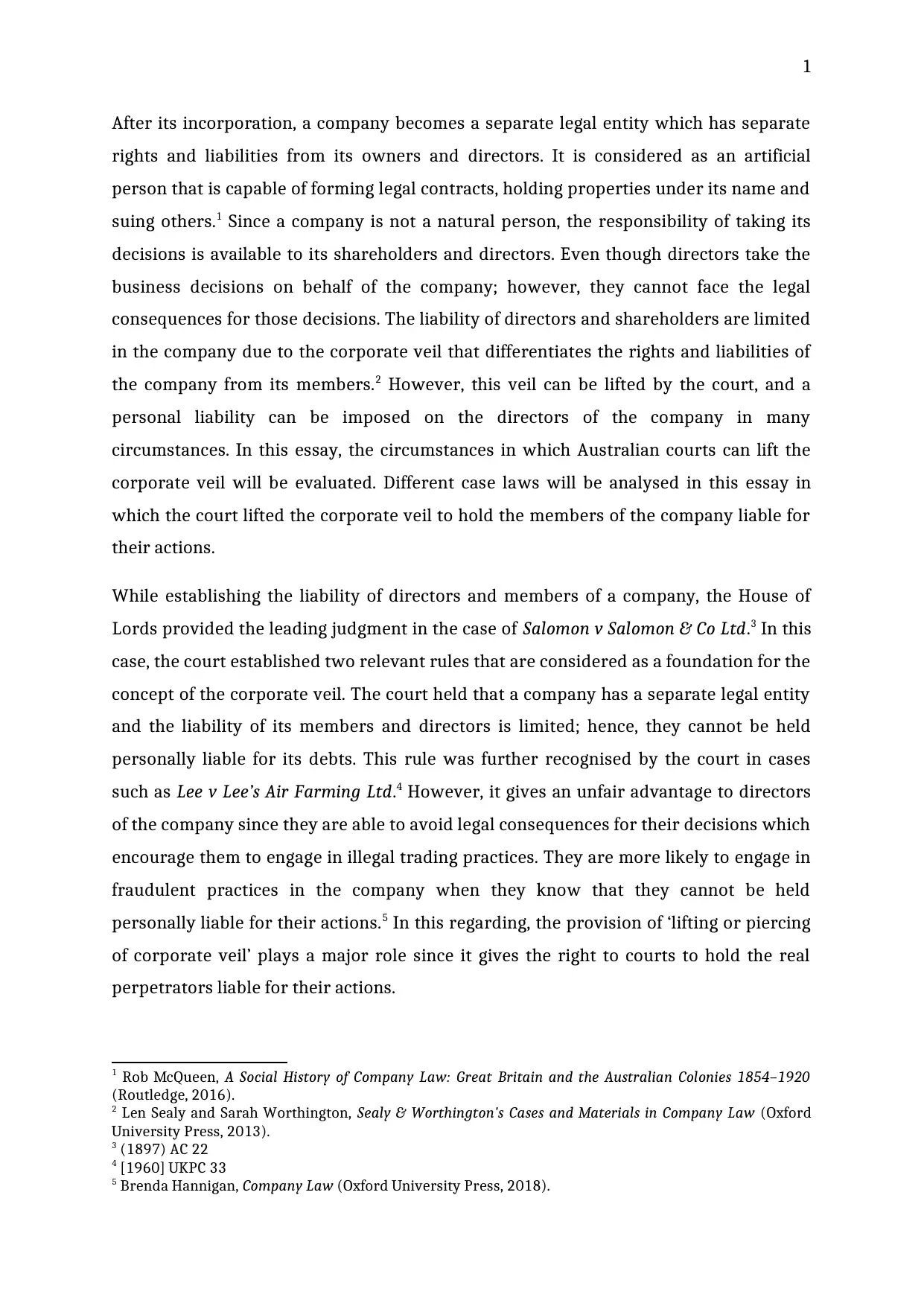
1
After its incorporation, a company becomes a separate legal entity which has separate
rights and liabilities from its owners and directors. It is considered as an artificial
person that is capable of forming legal contracts, holding properties under its name and
suing others.1 Since a company is not a natural person, the responsibility of taking its
decisions is available to its shareholders and directors. Even though directors take the
business decisions on behalf of the company; however, they cannot face the legal
consequences for those decisions. The liability of directors and shareholders are limited
in the company due to the corporate veil that differentiates the rights and liabilities of
the company from its members.2 However, this veil can be lifted by the court, and a
personal liability can be imposed on the directors of the company in many
circumstances. In this essay, the circumstances in which Australian courts can lift the
corporate veil will be evaluated. Different case laws will be analysed in this essay in
which the court lifted the corporate veil to hold the members of the company liable for
their actions.
While establishing the liability of directors and members of a company, the House of
Lords provided the leading judgment in the case of Salomon v Salomon & Co Ltd.3 In this
case, the court established two relevant rules that are considered as a foundation for the
concept of the corporate veil. The court held that a company has a separate legal entity
and the liability of its members and directors is limited; hence, they cannot be held
personally liable for its debts. This rule was further recognised by the court in cases
such as Lee v Lee’s Air Farming Ltd.4 However, it gives an unfair advantage to directors
of the company since they are able to avoid legal consequences for their decisions which
encourage them to engage in illegal trading practices. They are more likely to engage in
fraudulent practices in the company when they know that they cannot be held
personally liable for their actions.5 In this regarding, the provision of ‘lifting or piercing
of corporate veil’ plays a major role since it gives the right to courts to hold the real
perpetrators liable for their actions.
1 Rob McQueen, A Social History of Company Law: Great Britain and the Australian Colonies 1854–1920
(Routledge, 2016).
2 Len Sealy and Sarah Worthington, Sealy & Worthington's Cases and Materials in Company Law (Oxford
University Press, 2013).
3 (1897) AC 22
4 [1960] UKPC 33
5 Brenda Hannigan, Company Law (Oxford University Press, 2018).
After its incorporation, a company becomes a separate legal entity which has separate
rights and liabilities from its owners and directors. It is considered as an artificial
person that is capable of forming legal contracts, holding properties under its name and
suing others.1 Since a company is not a natural person, the responsibility of taking its
decisions is available to its shareholders and directors. Even though directors take the
business decisions on behalf of the company; however, they cannot face the legal
consequences for those decisions. The liability of directors and shareholders are limited
in the company due to the corporate veil that differentiates the rights and liabilities of
the company from its members.2 However, this veil can be lifted by the court, and a
personal liability can be imposed on the directors of the company in many
circumstances. In this essay, the circumstances in which Australian courts can lift the
corporate veil will be evaluated. Different case laws will be analysed in this essay in
which the court lifted the corporate veil to hold the members of the company liable for
their actions.
While establishing the liability of directors and members of a company, the House of
Lords provided the leading judgment in the case of Salomon v Salomon & Co Ltd.3 In this
case, the court established two relevant rules that are considered as a foundation for the
concept of the corporate veil. The court held that a company has a separate legal entity
and the liability of its members and directors is limited; hence, they cannot be held
personally liable for its debts. This rule was further recognised by the court in cases
such as Lee v Lee’s Air Farming Ltd.4 However, it gives an unfair advantage to directors
of the company since they are able to avoid legal consequences for their decisions which
encourage them to engage in illegal trading practices. They are more likely to engage in
fraudulent practices in the company when they know that they cannot be held
personally liable for their actions.5 In this regarding, the provision of ‘lifting or piercing
of corporate veil’ plays a major role since it gives the right to courts to hold the real
perpetrators liable for their actions.
1 Rob McQueen, A Social History of Company Law: Great Britain and the Australian Colonies 1854–1920
(Routledge, 2016).
2 Len Sealy and Sarah Worthington, Sealy & Worthington's Cases and Materials in Company Law (Oxford
University Press, 2013).
3 (1897) AC 22
4 [1960] UKPC 33
5 Brenda Hannigan, Company Law (Oxford University Press, 2018).
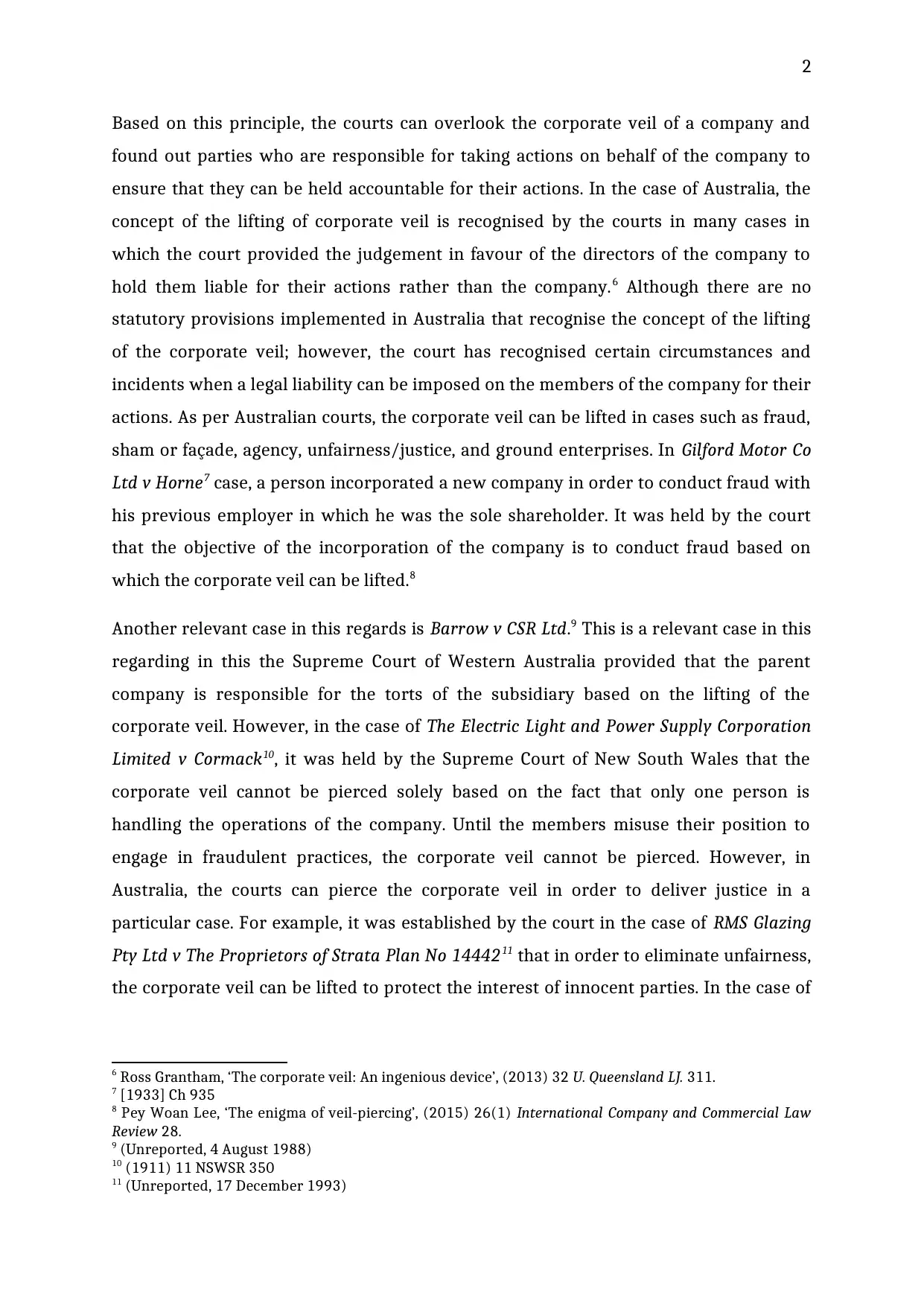
2
Based on this principle, the courts can overlook the corporate veil of a company and
found out parties who are responsible for taking actions on behalf of the company to
ensure that they can be held accountable for their actions. In the case of Australia, the
concept of the lifting of corporate veil is recognised by the courts in many cases in
which the court provided the judgement in favour of the directors of the company to
hold them liable for their actions rather than the company.6 Although there are no
statutory provisions implemented in Australia that recognise the concept of the lifting
of the corporate veil; however, the court has recognised certain circumstances and
incidents when a legal liability can be imposed on the members of the company for their
actions. As per Australian courts, the corporate veil can be lifted in cases such as fraud,
sham or façade, agency, unfairness/justice, and ground enterprises. In Gilford Motor Co
Ltd v Horne7 case, a person incorporated a new company in order to conduct fraud with
his previous employer in which he was the sole shareholder. It was held by the court
that the objective of the incorporation of the company is to conduct fraud based on
which the corporate veil can be lifted.8
Another relevant case in this regards is Barrow v CSR Ltd.9 This is a relevant case in this
regarding in this the Supreme Court of Western Australia provided that the parent
company is responsible for the torts of the subsidiary based on the lifting of the
corporate veil. However, in the case of The Electric Light and Power Supply Corporation
Limited v Cormack10, it was held by the Supreme Court of New South Wales that the
corporate veil cannot be pierced solely based on the fact that only one person is
handling the operations of the company. Until the members misuse their position to
engage in fraudulent practices, the corporate veil cannot be pierced. However, in
Australia, the courts can pierce the corporate veil in order to deliver justice in a
particular case. For example, it was established by the court in the case of RMS Glazing
Pty Ltd v The Proprietors of Strata Plan No 1444211 that in order to eliminate unfairness,
the corporate veil can be lifted to protect the interest of innocent parties. In the case of
6 Ross Grantham, ‘The corporate veil: An ingenious device’, (2013) 32 U. Queensland LJ. 311.
7 [1933] Ch 935
8 Pey Woan Lee, ‘The enigma of veil-piercing’, (2015) 26(1) International Company and Commercial Law
Review 28.
9 (Unreported, 4 August 1988)
10 (1911) 11 NSWSR 350
11 (Unreported, 17 December 1993)
Based on this principle, the courts can overlook the corporate veil of a company and
found out parties who are responsible for taking actions on behalf of the company to
ensure that they can be held accountable for their actions. In the case of Australia, the
concept of the lifting of corporate veil is recognised by the courts in many cases in
which the court provided the judgement in favour of the directors of the company to
hold them liable for their actions rather than the company.6 Although there are no
statutory provisions implemented in Australia that recognise the concept of the lifting
of the corporate veil; however, the court has recognised certain circumstances and
incidents when a legal liability can be imposed on the members of the company for their
actions. As per Australian courts, the corporate veil can be lifted in cases such as fraud,
sham or façade, agency, unfairness/justice, and ground enterprises. In Gilford Motor Co
Ltd v Horne7 case, a person incorporated a new company in order to conduct fraud with
his previous employer in which he was the sole shareholder. It was held by the court
that the objective of the incorporation of the company is to conduct fraud based on
which the corporate veil can be lifted.8
Another relevant case in this regards is Barrow v CSR Ltd.9 This is a relevant case in this
regarding in this the Supreme Court of Western Australia provided that the parent
company is responsible for the torts of the subsidiary based on the lifting of the
corporate veil. However, in the case of The Electric Light and Power Supply Corporation
Limited v Cormack10, it was held by the Supreme Court of New South Wales that the
corporate veil cannot be pierced solely based on the fact that only one person is
handling the operations of the company. Until the members misuse their position to
engage in fraudulent practices, the corporate veil cannot be pierced. However, in
Australia, the courts can pierce the corporate veil in order to deliver justice in a
particular case. For example, it was established by the court in the case of RMS Glazing
Pty Ltd v The Proprietors of Strata Plan No 1444211 that in order to eliminate unfairness,
the corporate veil can be lifted to protect the interest of innocent parties. In the case of
6 Ross Grantham, ‘The corporate veil: An ingenious device’, (2013) 32 U. Queensland LJ. 311.
7 [1933] Ch 935
8 Pey Woan Lee, ‘The enigma of veil-piercing’, (2015) 26(1) International Company and Commercial Law
Review 28.
9 (Unreported, 4 August 1988)
10 (1911) 11 NSWSR 350
11 (Unreported, 17 December 1993)
⊘ This is a preview!⊘
Do you want full access?
Subscribe today to unlock all pages.

Trusted by 1+ million students worldwide
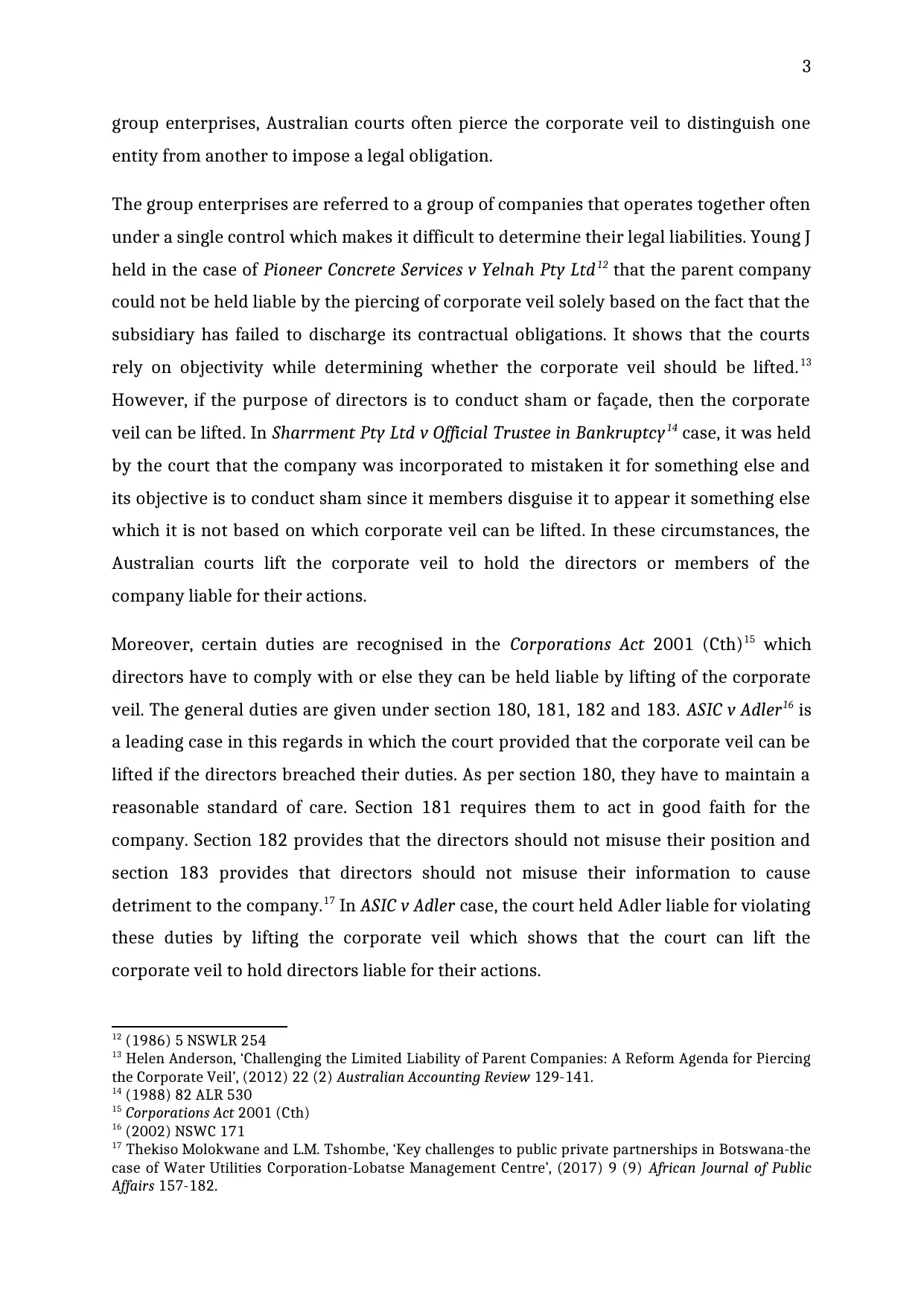
3
group enterprises, Australian courts often pierce the corporate veil to distinguish one
entity from another to impose a legal obligation.
The group enterprises are referred to a group of companies that operates together often
under a single control which makes it difficult to determine their legal liabilities. Young J
held in the case of Pioneer Concrete Services v Yelnah Pty Ltd12 that the parent company
could not be held liable by the piercing of corporate veil solely based on the fact that the
subsidiary has failed to discharge its contractual obligations. It shows that the courts
rely on objectivity while determining whether the corporate veil should be lifted.13
However, if the purpose of directors is to conduct sham or façade, then the corporate
veil can be lifted. In Sharrment Pty Ltd v Official Trustee in Bankruptcy14 case, it was held
by the court that the company was incorporated to mistaken it for something else and
its objective is to conduct sham since it members disguise it to appear it something else
which it is not based on which corporate veil can be lifted. In these circumstances, the
Australian courts lift the corporate veil to hold the directors or members of the
company liable for their actions.
Moreover, certain duties are recognised in the Corporations Act 2001 (Cth)15 which
directors have to comply with or else they can be held liable by lifting of the corporate
veil. The general duties are given under section 180, 181, 182 and 183. ASIC v Adler16 is
a leading case in this regards in which the court provided that the corporate veil can be
lifted if the directors breached their duties. As per section 180, they have to maintain a
reasonable standard of care. Section 181 requires them to act in good faith for the
company. Section 182 provides that the directors should not misuse their position and
section 183 provides that directors should not misuse their information to cause
detriment to the company.17 In ASIC v Adler case, the court held Adler liable for violating
these duties by lifting the corporate veil which shows that the court can lift the
corporate veil to hold directors liable for their actions.
12 (1986) 5 NSWLR 254
13 Helen Anderson, ‘Challenging the Limited Liability of Parent Companies: A Reform Agenda for Piercing
the Corporate Veil’, (2012) 22 (2) Australian Accounting Review 129-141.
14 (1988) 82 ALR 530
15 Corporations Act 2001 (Cth)
16 (2002) NSWC 171
17 Thekiso Molokwane and L.M. Tshombe, ‘Key challenges to public private partnerships in Botswana-the
case of Water Utilities Corporation-Lobatse Management Centre’, (2017) 9 (9) African Journal of Public
Affairs 157-182.
group enterprises, Australian courts often pierce the corporate veil to distinguish one
entity from another to impose a legal obligation.
The group enterprises are referred to a group of companies that operates together often
under a single control which makes it difficult to determine their legal liabilities. Young J
held in the case of Pioneer Concrete Services v Yelnah Pty Ltd12 that the parent company
could not be held liable by the piercing of corporate veil solely based on the fact that the
subsidiary has failed to discharge its contractual obligations. It shows that the courts
rely on objectivity while determining whether the corporate veil should be lifted.13
However, if the purpose of directors is to conduct sham or façade, then the corporate
veil can be lifted. In Sharrment Pty Ltd v Official Trustee in Bankruptcy14 case, it was held
by the court that the company was incorporated to mistaken it for something else and
its objective is to conduct sham since it members disguise it to appear it something else
which it is not based on which corporate veil can be lifted. In these circumstances, the
Australian courts lift the corporate veil to hold the directors or members of the
company liable for their actions.
Moreover, certain duties are recognised in the Corporations Act 2001 (Cth)15 which
directors have to comply with or else they can be held liable by lifting of the corporate
veil. The general duties are given under section 180, 181, 182 and 183. ASIC v Adler16 is
a leading case in this regards in which the court provided that the corporate veil can be
lifted if the directors breached their duties. As per section 180, they have to maintain a
reasonable standard of care. Section 181 requires them to act in good faith for the
company. Section 182 provides that the directors should not misuse their position and
section 183 provides that directors should not misuse their information to cause
detriment to the company.17 In ASIC v Adler case, the court held Adler liable for violating
these duties by lifting the corporate veil which shows that the court can lift the
corporate veil to hold directors liable for their actions.
12 (1986) 5 NSWLR 254
13 Helen Anderson, ‘Challenging the Limited Liability of Parent Companies: A Reform Agenda for Piercing
the Corporate Veil’, (2012) 22 (2) Australian Accounting Review 129-141.
14 (1988) 82 ALR 530
15 Corporations Act 2001 (Cth)
16 (2002) NSWC 171
17 Thekiso Molokwane and L.M. Tshombe, ‘Key challenges to public private partnerships in Botswana-the
case of Water Utilities Corporation-Lobatse Management Centre’, (2017) 9 (9) African Journal of Public
Affairs 157-182.
Paraphrase This Document
Need a fresh take? Get an instant paraphrase of this document with our AI Paraphraser
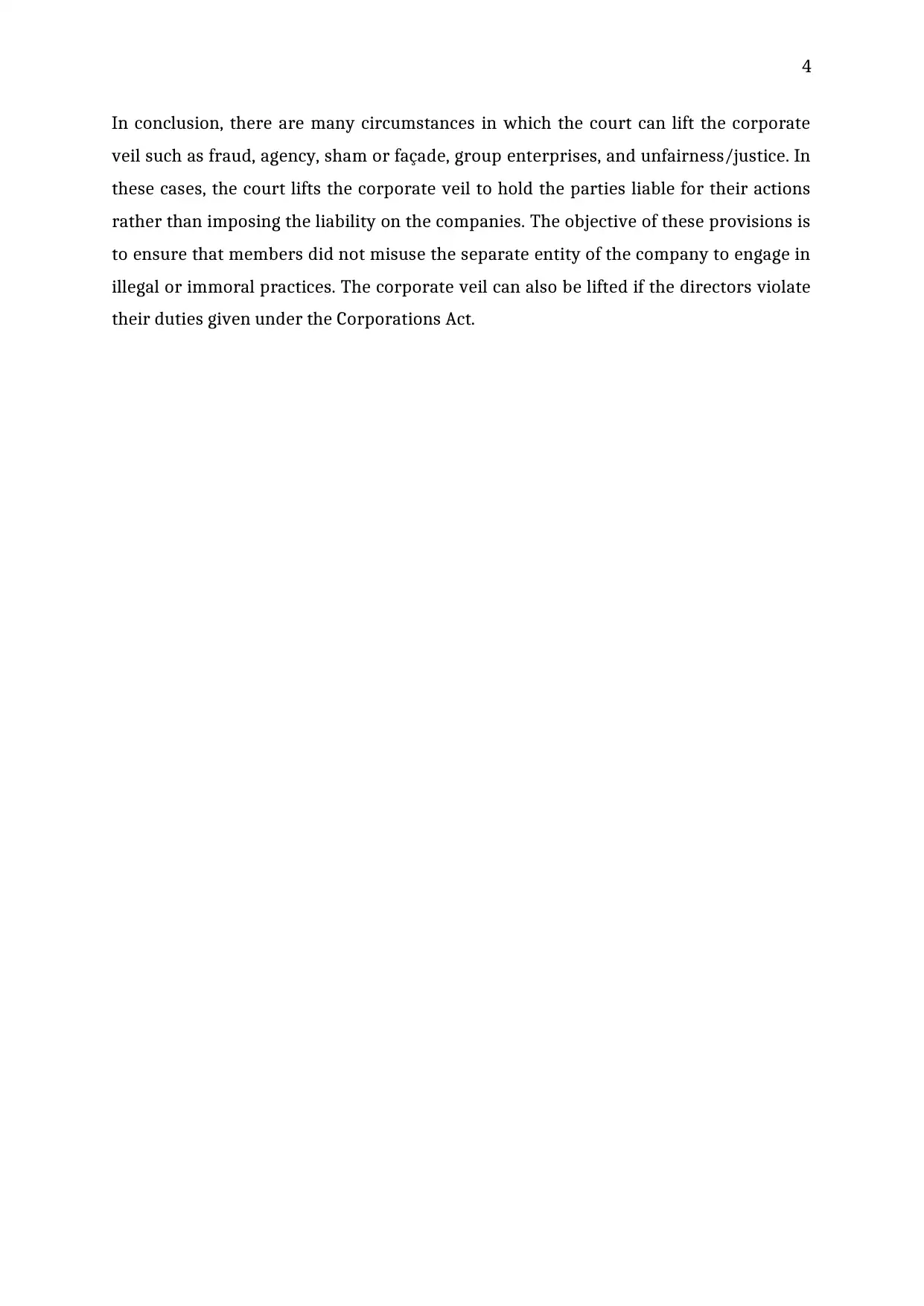
4
In conclusion, there are many circumstances in which the court can lift the corporate
veil such as fraud, agency, sham or façade, group enterprises, and unfairness/justice. In
these cases, the court lifts the corporate veil to hold the parties liable for their actions
rather than imposing the liability on the companies. The objective of these provisions is
to ensure that members did not misuse the separate entity of the company to engage in
illegal or immoral practices. The corporate veil can also be lifted if the directors violate
their duties given under the Corporations Act.
In conclusion, there are many circumstances in which the court can lift the corporate
veil such as fraud, agency, sham or façade, group enterprises, and unfairness/justice. In
these cases, the court lifts the corporate veil to hold the parties liable for their actions
rather than imposing the liability on the companies. The objective of these provisions is
to ensure that members did not misuse the separate entity of the company to engage in
illegal or immoral practices. The corporate veil can also be lifted if the directors violate
their duties given under the Corporations Act.
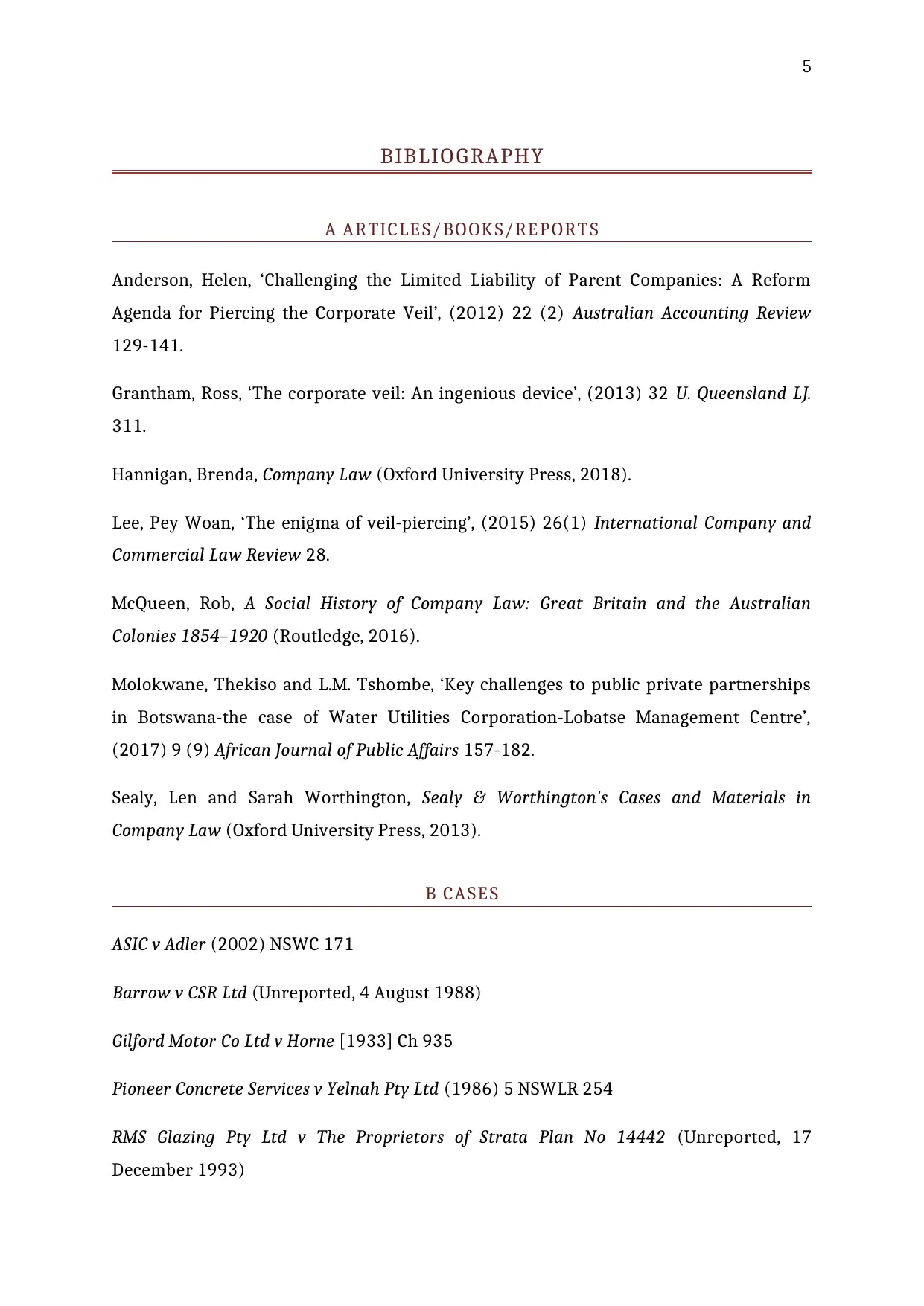
5
BIBLIOGRAPHY
A ARTICLES/BOOKS/REPORTS
Anderson, Helen, ‘Challenging the Limited Liability of Parent Companies: A Reform
Agenda for Piercing the Corporate Veil’, (2012) 22 (2) Australian Accounting Review
129-141.
Grantham, Ross, ‘The corporate veil: An ingenious device’, (2013) 32 U. Queensland LJ.
311.
Hannigan, Brenda, Company Law (Oxford University Press, 2018).
Lee, Pey Woan, ‘The enigma of veil-piercing’, (2015) 26(1) International Company and
Commercial Law Review 28.
McQueen, Rob, A Social History of Company Law: Great Britain and the Australian
Colonies 1854–1920 (Routledge, 2016).
Molokwane, Thekiso and L.M. Tshombe, ‘Key challenges to public private partnerships
in Botswana-the case of Water Utilities Corporation-Lobatse Management Centre’,
(2017) 9 (9) African Journal of Public Affairs 157-182.
Sealy, Len and Sarah Worthington, Sealy & Worthington's Cases and Materials in
Company Law (Oxford University Press, 2013).
B CASES
ASIC v Adler (2002) NSWC 171
Barrow v CSR Ltd (Unreported, 4 August 1988)
Gilford Motor Co Ltd v Horne [1933] Ch 935
Pioneer Concrete Services v Yelnah Pty Ltd (1986) 5 NSWLR 254
RMS Glazing Pty Ltd v The Proprietors of Strata Plan No 14442 (Unreported, 17
December 1993)
BIBLIOGRAPHY
A ARTICLES/BOOKS/REPORTS
Anderson, Helen, ‘Challenging the Limited Liability of Parent Companies: A Reform
Agenda for Piercing the Corporate Veil’, (2012) 22 (2) Australian Accounting Review
129-141.
Grantham, Ross, ‘The corporate veil: An ingenious device’, (2013) 32 U. Queensland LJ.
311.
Hannigan, Brenda, Company Law (Oxford University Press, 2018).
Lee, Pey Woan, ‘The enigma of veil-piercing’, (2015) 26(1) International Company and
Commercial Law Review 28.
McQueen, Rob, A Social History of Company Law: Great Britain and the Australian
Colonies 1854–1920 (Routledge, 2016).
Molokwane, Thekiso and L.M. Tshombe, ‘Key challenges to public private partnerships
in Botswana-the case of Water Utilities Corporation-Lobatse Management Centre’,
(2017) 9 (9) African Journal of Public Affairs 157-182.
Sealy, Len and Sarah Worthington, Sealy & Worthington's Cases and Materials in
Company Law (Oxford University Press, 2013).
B CASES
ASIC v Adler (2002) NSWC 171
Barrow v CSR Ltd (Unreported, 4 August 1988)
Gilford Motor Co Ltd v Horne [1933] Ch 935
Pioneer Concrete Services v Yelnah Pty Ltd (1986) 5 NSWLR 254
RMS Glazing Pty Ltd v The Proprietors of Strata Plan No 14442 (Unreported, 17
December 1993)
⊘ This is a preview!⊘
Do you want full access?
Subscribe today to unlock all pages.

Trusted by 1+ million students worldwide
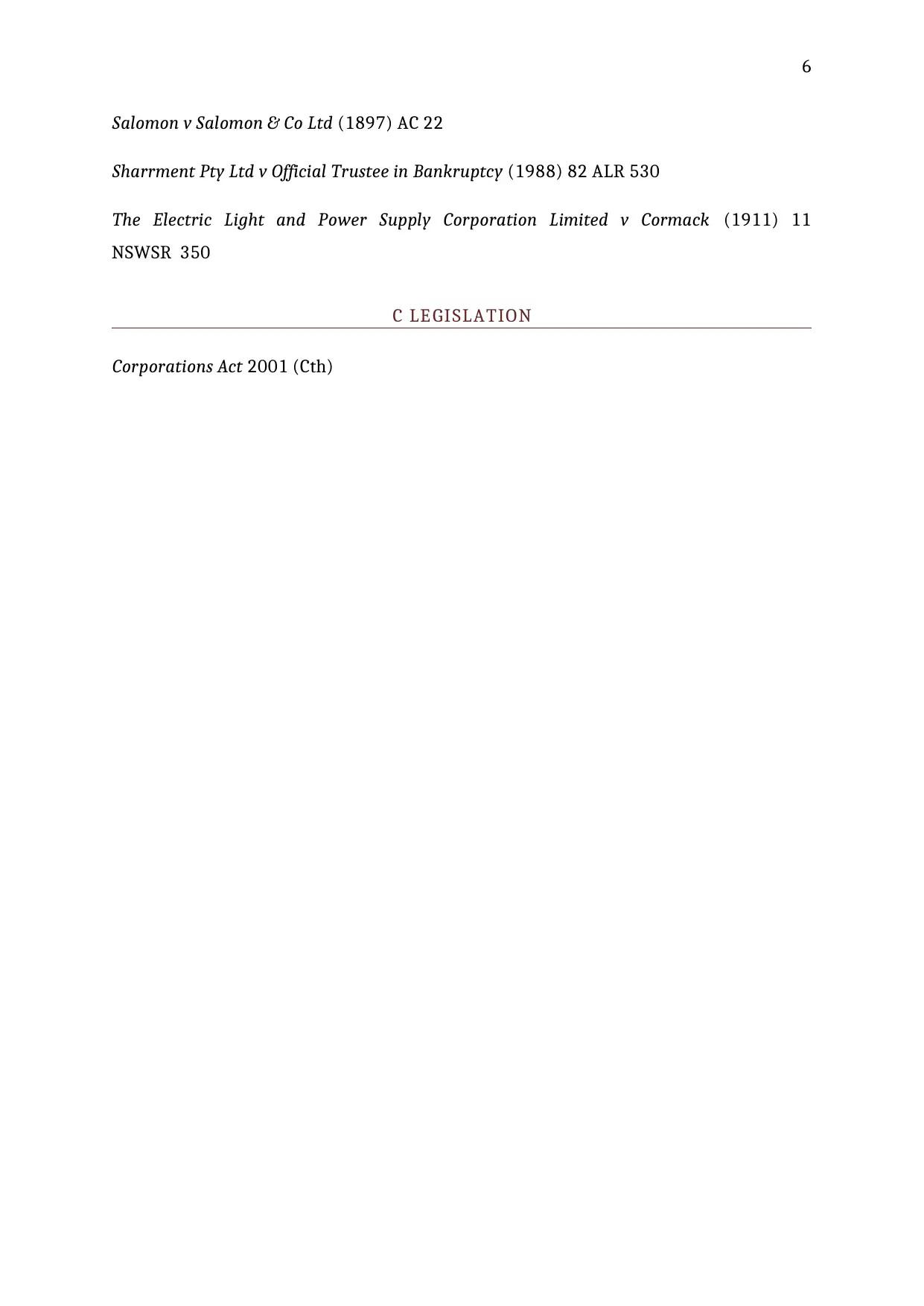
6
Salomon v Salomon & Co Ltd (1897) AC 22
Sharrment Pty Ltd v Official Trustee in Bankruptcy (1988) 82 ALR 530
The Electric Light and Power Supply Corporation Limited v Cormack (1911) 11
NSWSR 350
C LEGISLATION
Corporations Act 2001 (Cth)
Salomon v Salomon & Co Ltd (1897) AC 22
Sharrment Pty Ltd v Official Trustee in Bankruptcy (1988) 82 ALR 530
The Electric Light and Power Supply Corporation Limited v Cormack (1911) 11
NSWSR 350
C LEGISLATION
Corporations Act 2001 (Cth)
1 out of 7
Related Documents
Your All-in-One AI-Powered Toolkit for Academic Success.
+13062052269
info@desklib.com
Available 24*7 on WhatsApp / Email
![[object Object]](/_next/static/media/star-bottom.7253800d.svg)
Unlock your academic potential
Copyright © 2020–2025 A2Z Services. All Rights Reserved. Developed and managed by ZUCOL.





